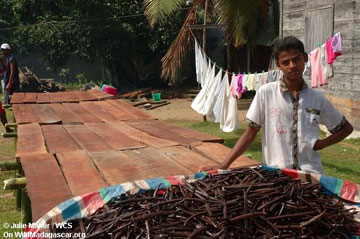Madagascar cyclones may be boon to vanilla market
Madagascar cyclones may be boon to vanilla market
mongabay.com
March 27, 2007
A string of destructive cyclones that have struck the Indian island nation of Madagascar, off the southeastern coast of Africa, may serve as a boon to the depressed vanilla market. Madagascar, the largest producer of vanilla, will likely see production fall due to the havoc wreaked by the storms, which displaced more than 100,000 people. At the same time, the reduction in supply is sure to boost prices for other growers able to bring product to market.
The vanilla supply glut and corresponding low prices are partly the result of past cyclones in Madagascar. In 2002 storms destroyed much of the country’s crop causing prices of the vanilla to skyrocket. The high prices spurred other countries including Papua New Guinea, Uganda, India, Costa Rica and Colombia to enter the vanilla business. Their production came online in 2004-2005, just as Madagascar’s vanilla supply returned, causing wholesale bean prices the collapse by almost 90 percent from their peak in December 2003.
Vanilla is the only orchid that produces an edible fruit. Originally from Mexico, vanilla was introduced to Madagascar during the nineteenth century, but without the native pollinators (bees and hummingbirds) local growers must hand pollinate the plant. This makes vanilla perhaps the most labor-intensive crop in the world, taking as long as five years between first planting the vine and producing aged extract.
 Vanilla bean cultivation and drying process. Photo by Julie Larsen Maher / WCS. |
Due to work required to produce vanilla, beans and extract have an exceedingly high value relative to other spices and flavorings. Vanilla growers in some parts of Madagascar employ guards and brand their beans with small pin pricks on each bean — much like cattle branding — to prevent theft. Vanilla has created a regional income disparity on the island with the vanilla producing regions of Madagascar being among the wealthiest parts of the country, which overall, is one of the poorest in the world. Most Malagasy live on less than a dollar per day and nearly half of its children under five years of age are malnourished.
For the vanilla farmers who were able to escape the recent cyclones unscathed, their neighbors’ misfortune may be their biggest break in years.
Anita, Bondo, Clovis, Favio, and Indlala are the storms that battered Madagascar this cyclone season. According to initial government estimates, about 80 percent of the country’s vanilla production was lost to Indlala, the storm that hit northeastern Madagascar last week.